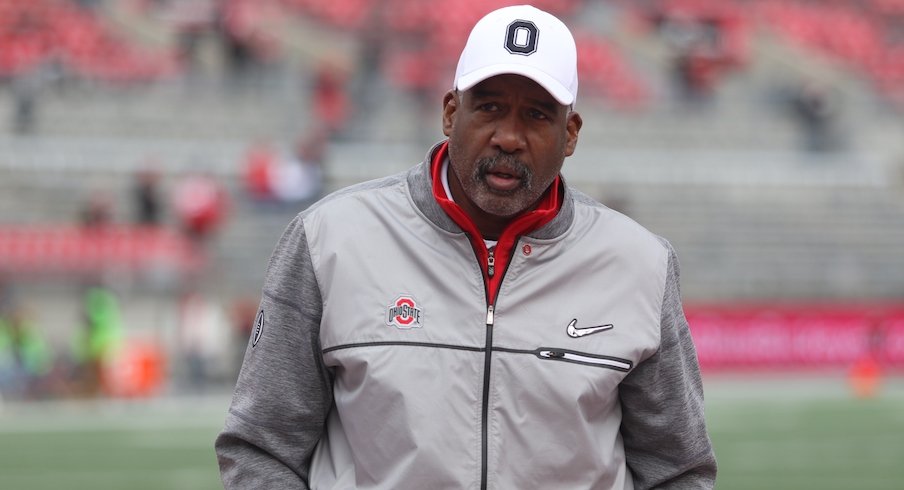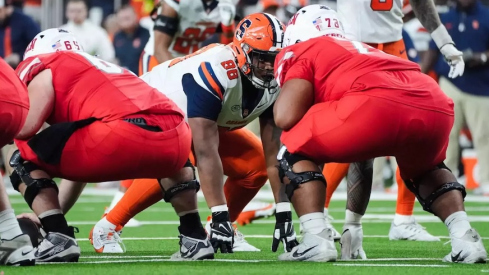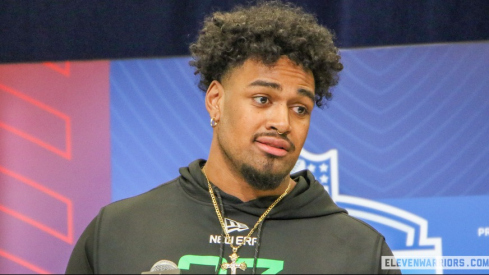If Ohio State and other colleges around the country are going to play football this fall, they’re probably going to have to accept some increased risk along the way.
Unless a vaccine for COVID-19 can be fast-tracked and mass-produced in record time, the coronavirus pandemic isn’t going to be over in the next four months. It’s unlikely that the threat of COVID-19, which has already been attributed to more than 90,000 deaths in the United States, will be eradicated in 2020, and some medical experts have cautioned that the pandemic could last as long as two years.
Even so, most states – including Ohio – have begun to lift many of the restrictions they put in place to slow the spread of the disease. Several professional sports have resumed, including UFC and NASCAR, with others potentially soon to follow. And with the NCAA’s vote on Wednesday allowing college football and basketball players to resume voluntary on-campus workouts on June 1, momentum appears to be steadily increasing for NCAA football to be played as scheduled this fall after the pandemic brought an abrupt end to winter and spring sports in March.
Ohio State athletic director Gene Smith, who had previously said in April that he struggled to see college football being played without fans, is seeing that momentum and becoming increasingly optimistic himself that the Buckeyes will play this fall and even that Ohio Stadium will be able to host fans, albeit likely at a reduced capacity that could range from 20,000 to 50,000.
“I’m optimistic that we’ll have a season, some form of a season,” Smith said during an interview on 97.1 The Fan’s The Buckeye Show on Wednesday.
Because he knows the risks of the coronavirus outbreak are still real, though, Smith acknowledges that he still has concerns about whether it will be safe for the Buckeyes to be playing football games again in September.
“I’m not 100 percent comfortable yet,” Smith said during a teleconference with reporters on Wednesday. “I am cautiously optimistic that I’m gonna reach 100 percent comfort level, but I’m not there yet. Just like I’m not there 100 percent with fans in the stands. I think we have to be sensitive to the fact that our medical experts – not athletic directors or commissioners or everyone else – have to give us the proper environment and operations in that environment that will allow us to play the game. And we haven’t had that in-depth conversation yet. And frankly, it’s a little early, because we still are studying the virus.”
As he has every time he has spoken publicly over the past two months, Smith made it clear on Wednesday that the health and safety of Ohio State’s student-athletes, coaches and staff and everyone else who could potentially be affected by the university’s decisions on whether to hold athletic events will continue to be his top priority in every decision he has a hand in making.
“People are losing their lives, and that’s just unsettling,” Smith said. “I certainly wouldn’t want to have an event where we’re putting people in a situation where we’re gonna stress our medical system because we weren’t being responsible. So I think we gotta be thoughtful about the human part of this whole thing, first and foremost. It’s just who I am. It’s just the way I operate.”
Smith’s hope is that medical experts will come up with enough solutions over the next couple of months so that college football can be played – and that at least some fans can be inside stadiums watching – without a substantially increased risk of COVID-19 infections.
Realistically, though, it’s going to be difficult to mitigate that risk entirely. After all, football is a contact sport, which makes it impossible to maintain social distancing during games or practices. Football players wearing face coverings during games or practices is “unrealistic,” Smith said Wednesday. Given that carriers of COVID-19 are often asymptomatic and the disease is contagious, the possibility of a football player unknowingly transmitting the virus to teammates and opponents is very real.
The question that could ultimately determine whether college football is played as scheduled, when teams are even allowed to practice again and how many fans will be allowed to attend games – if any – is just how much risk everyone involved is willing to take.
”I think we gotta be thoughtful about the human part of this whole thing, first and foremost. It’s just who I am. It’s just the way I operate.”– Ohio State athletic director Gene Smith
For young, otherwise healthy football players who are at lower risk of suffering serious complications from COVID-19 themselves, that answer will likely be easy for most. Ohio State offensive linemen Josh Myers and Wyatt Davis have already said they “would do anything” to be able to play for the Buckeyes this year, and Smith believes that feeling is widespread throughout the team.
“We’re not even close to having anyone that’s thinking about not playing,” Smith said on 97.1. “I think as we get closer to understanding of protocol, and we actually can talk about, ‘OK, this is how it’s going to work,’ then you have a chance to look at it and say, ‘OK, I feel good about it or I don’t.’ But we’re not even in that space. Our guys are jacked. We could play tomorrow, they all would have played tomorrow.”
Former Ohio State linebacker Joshua Perry said on this week’s Real Pod Wednesdays that he and his teammates would have felt the same way.
“I think almost anybody would have done it,” Perry said. “Even if that meant that I couldn’t spend much time around friends and family outside of workouts, I would have made that sacrifice for sure, because the game is that important. And I truly feel that a lot of players will live a very restrictive lifestyle if need be to make sure that they can compete on the level that they want to.”
Perry, who retired from the NFL after just two seasons in the league due to concussions, also believes that because there are already inherent risks that come from playing football, most players who have already accepted those risks will be willing to accept the coronavirus risk, too.
“Nobody should feel pressure, nobody should be ostracized if they think the risk is too high,” Perry said. “But again, these guys are playing a risky game so I doubt any of them are gonna worry too much as long as they have a plan in place that shows that it’s gonna be safe to come back.”
Ohio State will surely do whatever it can to create the best possible environment to limit the risk of COVID-19 – and to limit the risk of increased injuries when players return to the field after months away from campus – but within the next couple months, the Buckeyes have to make the leap from their current plan of allowing just 10 players to work out together at a time to training together as an entire team so they can actually practice football.
That requires a level of trust from many different parties – including the NCAA and the Big Ten, university leaders and medical experts at Ohio State, players and their parents – that enough safeguards are in place to decrease the likelihood of a coronavirus outbreak throughout college football. Myers is among those who have expressed confidence that at least at Ohio State, every precaution possible to protect the players’ health without hindering their performance will be taken.
“I think I could speak for pretty much everybody on our team when I say that we trust our coaches, we trust our medical staff and we know that they’re going to try and do right by us and keep us safe while also getting work in that we need to get in,” Myers said.
That said, Perry thinks it’s important to be realistic about what can and can’t be done.
“I think it’s disingenuous and damn near impossible to tell these guys that they have to keep distance while they’re at the facility. Because naturally, they’re gonna want to dap each other up. Naturally, the lockers are too close to even try to create a locker room space where guys aren’t in close quarters getting dressed together,” Perry said. “So if these guys come back, I think it also has to be a known risk on everybody’s behalf.”
Ohio State won’t be unilaterally deciding what constitutes acceptable risk for a 2020 college football season. Some of those decisions could be made for them by the NCAA, Big Ten or the state of Ohio, while each of its scheduled opponents will also have to decide whether to host games or make the trip to Columbus this season.
Still, Ohio State will have to make some tough decisions along the way to strike the proper balance between playing as many games as possible and having the best season possible while also prioritizing the health of its players, fans and everyone else in and around the program.
“Our kids want to play … so I want to make sure that we, first and foremost with their health and safety in mind, whatever we can do to give them that chance, I want to bend over backward to give them that chance,” Smith said.


